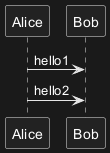@startuml
then ends with the keyword @enduml or (@startXYZ and @endXYZ, depending of the kind of diagram).
You can refer to the PlantUML Language Reference Guide.
Those descriptions may be included into:
.png, .svg) has the same name as the source file used to generate it (only the extension changes).
If a source file contains several instances of @startXXX then a subfolder is made, and an automatic sequence is added to the output file names.
It is also possible to specify specific output filenames per diagram. For example:
@startuml image
Alice->Bob: Authentication Request
Bob-->Alice: Authentication Response
@enduml
In this example, the output file will be named
image.png for output format -tpng (which is the default). You can also specify an extension, but it will be ignored if it doesn't match the output format.
(Please note that you should not use this feature with Word integration.)
id=<identifier>), as:
Example with a file named file.pu:
@startuml(id=TAG1)
Alice->Bob : TAG1
@enduml
@startuml(id=TAG2)
Alice->Bob : TAG2
@enduml
Then you can include, on one another file, one
id part with !include <filemane>!<id> command:
@startuml
!include file.pu!TAG2
Alice->Bob : hello
@enduml
The corresponding generated output will be:
|
🎉 Copied!
|

|
[Ref. QA-4467]
def) some part on a file with an identifier between the tags @startdef(id=<identifier>) and @enddef.
Then you can include, on the same file, only one definition part with !includedef <identifier> command.
Example on a file named file.pu:
|
🎉 Copied!
|
|
Then the corresponding generated output will be
file_001.png, as:
|
🎉 Copied!
|

|
[Ref. QA-5769]
{ and }.
Only the first (<filename>) is relevant for PlantUML, the others are just skipped, and can be use by other tools.
@startuml{filename.png, This is my other caption text, width=16cm, option_for_other_tools=value}
@enduml
[Ref. QA-1466]
pipe modepipe mode.
To specify the output format (PNG, SVG, ATXT or UTXT), on pipe mode, you can add this command on the input:
@@@format png
or
@@@format svg
or
@@@format UTXT
[Ref. QA-10808, GH-1810]
@pause, @unpause and @append]@pause@unpause@append
/// My FSM looks like this:
/// @startuml myfsm
/// title My Finite-state machine
/// @pause
enum {
// @append state AA
STATE_AA,
// @append state BB
STATE_BB,
};
struct fsm my_fsm = {
// @append [*] -> AA: Event 1
{ STATE_ENRTY, EVENT_1, STATE_AA },
// @append AA -> BB: Event 3
{ STATE_AA, EVENT_3, STATE_BB },
// and so on with a bunch of transitions...
};
/// @unpause
/// @enduml
Here is the corresponding diagram generated from the previous input:

[Ref. QA-1525, QA-5793]